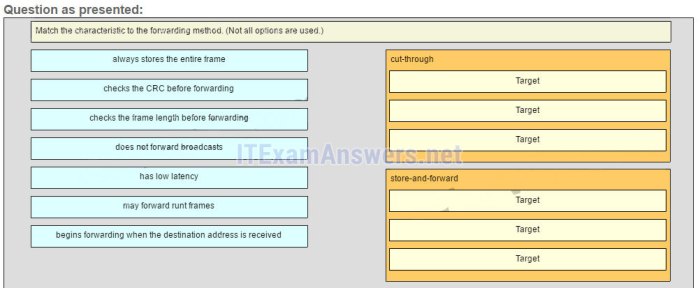Match the characteristic to the forwarding method – In the realm of network communication, understanding the intricacies of forwarding methods and their characteristics is paramount. By matching the appropriate forwarding method to specific requirements, network performance can be optimized, ensuring seamless data transmission and application responsiveness. This comprehensive guide delves into the key forwarding methods, their characteristics, and their impact on network performance, empowering readers with the knowledge to make informed decisions for their network infrastructure.
As we explore the different forwarding methods, we will uncover the trade-offs involved in choosing a particular method based on its reliability, latency, and throughput. We will also examine real-world examples and case studies to illustrate how these methods have been successfully deployed to address network challenges.
Forwarding Methods and Their Characteristics: Match The Characteristic To The Forwarding Method

In network communication, data is forwarded from one network device to another to reach its intended destination. Different forwarding methods are employed to achieve this, each with its own characteristics.
Reliability
Reliability refers to the ability of a forwarding method to deliver data without errors or loss. Reliable forwarding methods, such as TCP, ensure that data is acknowledged and retransmitted if necessary, guaranteeing delivery.
Latency
Latency is the delay between sending and receiving data. Low-latency forwarding methods, such as UDP, prioritize speed over reliability, making them suitable for applications that require real-time responsiveness.
Throughput, Match the characteristic to the forwarding method
Throughput is the rate at which data is transferred over a network. High-throughput forwarding methods, such as IP multicast, enable efficient transmission of data to multiple destinations.
Matching Characteristics to Forwarding Methods
| Forwarding Method | Reliability | Latency | Throughput |
|---|---|---|---|
| TCP | Reliable | High | Moderate |
| UDP | Unreliable | Low | High |
| IP Multicast | Unreliable | Moderate | Very high |
The choice of forwarding method depends on the specific requirements of the application. Reliable methods are preferred for critical data, while low-latency methods are suitable for applications that require immediate response.
Impact of Characteristics on Network Performance
The characteristics of a forwarding method can significantly impact network performance.
- Reliability:Reliable methods ensure data delivery but may introduce delays due to retransmissions.
- Latency:Low-latency methods minimize delays but may sacrifice reliability.
- Throughput:High-throughput methods enable fast data transfer but may require specialized hardware.
By carefully selecting the appropriate forwarding method, network administrators can optimize performance for specific applications.
Case Studies and Real-World Examples
Forwarding methods have been used in various real-world applications:
- TCP:Used in web browsing, file transfers, and email to ensure reliable data delivery.
- UDP:Used in online gaming, streaming media, and voice over IP (VoIP) for low-latency communication.
- IP Multicast:Used in video conferencing and multimedia distribution to efficiently transmit data to multiple receivers.
By understanding the characteristics and trade-offs of different forwarding methods, network engineers can make informed decisions to optimize network performance and meet the specific requirements of their applications.
Question & Answer Hub
What is the key difference between unicast and multicast forwarding?
Unicast forwarding delivers data to a single destination, while multicast forwarding sends data to multiple destinations simultaneously.
How does the choice of forwarding method impact network latency?
Forwarding methods with lower latency, such as cut-through forwarding, can significantly improve network responsiveness and reduce delays in data transmission.
What are some real-world examples of how forwarding methods have been used to solve network challenges?
Software-defined networking (SDN) leverages forwarding methods to dynamically adjust network traffic flow, optimizing performance and improving network utilization.

